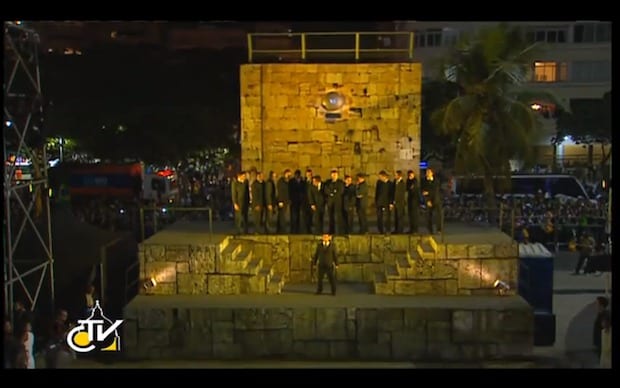
Crowds gathered at “Popacabana” for the Via Crucis on Friday evening
I watched it on a jumbotron, ready to be sometimes confused, occasionally prayerful, and mostly bored. It was going to be standard, if Catholic, public pageantry, but lacking the usual commentary track of disembodied voices speaking quasi-reverently over the spectacle, explaining both the meaning of the symbolism and the engineering required to achieve it.
At that level, it could have been anything — the 2008 Beijing games that hold the record (over a billion viewers) for the most watched television program in history, or the recent royal baby announcement on its easel, or even the announcement of Pope Francis’s election. But this was the Via Crucis of World Youth Day, a liturgy that for all its theater and a crowd of over a million only gets the commentary treatment from full-time Catholic media.
And honestly, for this daily dose of WYD pope-watching, I wasn’t expecting to need the commentary: a bearded man wrapped in a tunic carries a cross while adopting tableau vivant positions during which meditations on the Passion, varying from mundane to spiritually challenging, are read aloud. So I moseyed toward the series of giant screens on Copacabana Beach, stopping several times to snap more photos of pilgrims surprised by the tide, pausing reverently when the pope said the opening prayer, confident that I would not miss much during these wanderings.
But when I finally found myself in front of one of the screens, I realized I needed the commentary track, wondering: What is this? Where is Jesus? Why is the subject of the procession only a cross, albeit a cross that is made to twirl mesmerizingly in the deft hands of its bearers? Who are those costumed performers enacting roles that correspond to no scene of the passion I have ever heard before? And what grand Architect planned to augment the soaring orchestral music with the dramatic crashing of waves from the ever-strengthening tide? (This video presents the entire evening’s activities, including the pope’s arrival procession. The Via Crucis begins at 43:30.)

The Eleventh Station — Jesus (as a businessman? by businessmen?) is Nailed to the Cross
Screen capture from linked YouTube video
The eleventh station—Jesus being nailed to the cross—cemented my fascination. (The moment is here in the video.) Instead of Jesus, however, the scene begins with a single man dressed smartly in a black business suit aggressively jumping from a ledge in front of a stone wall. Behind him emerges a line of similarly dressed businessmen, and together they adopt a menacing pose. Again I had more questions than answers. Did they mean to suggest that the heartless corporations and the lords of finance killed Jesus? After all, even the pope’s final address later that night would lament the way in which selfishness, corruption, and hunger crucify the people of God.
In the next moment, though, this facile interpretation fell apart. The group of men falls down confused, and two of them grab hold of and confine one of their counterparts. If Jesus must be the one subjected to violence, then this suggests that Jesus himself wears a business suit. By the end of the scene, all of the men adopt a pose of adoration before the cross, and a new businessman with a bright yellow tie preaches to the others the station’s meditation: Jesus’ all embracing forgiveness intends to free both those in physical and in spiritual prisons.
As I struggled with this ambiguity, I was struck again by the audacity of good Catholic art: nothing truly human is foreign. Business and economic life can be celebrated and appreciated for the good that it does in helping us to live more humanely. They are not demonized. Yet —and this is a big yet — the gospel can still prophetically critique business and economic systems when appropriate. The gospel neither aims at nor depends on worldly prosperity, and discipleship should lead us to those in all sorts of prisons. If it doesn’t, then we may well find ourselves distant from Jesus, who places himself right alongside the prisoner, the outsider, and the indigent.
It’s not Beijing-scale Olympic pageantry; even with the effort devoted to World Youth Day, neither the Vatican nor Rio de Janeiro have the kinds of extravagant resources necessary. What they — and we — do have is a message that’s both more complex and more hopeful than can be explained in voice-over commentary. It demands not just understanding, but conversion: to hear and to see all that is beautiful and precious in our human existence, and to struggle for freedom from all that confines and oppresses it.


